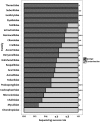Barcoding sponges: an overview based on comprehensive sampling
- PMID: 22802937
- PMCID: PMC3389008
- DOI: 10.1371/journal.pone.0039345
Barcoding sponges: an overview based on comprehensive sampling
Abstract
Background: Phylum Porifera includes ∼8,500 valid species distributed world-wide in aquatic ecosystems ranging from ephemeral fresh-water bodies to coastal environments and the deep-sea. The taxonomy and systematics of sponges is complicated, and morphological identification can be both time consuming and erroneous due to phenotypic convergence and secondary losses, etc. DNA barcoding can provide sponge biologists with a simple and rapid method for the identification of samples of unknown taxonomic membership. The Sponge Barcoding Project (www.spongebarcoding.org), the first initiative to barcode a non-bilaterian metazoan phylum, aims to provide a comprehensive DNA barcode database for Phylum Porifera.
Methodology/principal findings: ∼7,400 sponge specimens have been extracted, and amplification of the standard COI barcoding fragment has been attempted for approximately 3,300 museum samples with ∼25% mean amplification success. Based on this comprehensive sampling, we present the first report on the workflow and progress of the sponge barcoding project, and discuss some common pitfalls inherent to the barcoding of sponges.
Conclusion: A DNA-barcoding workflow capable of processing potentially large sponge collections has been developed and is routinely used for the Sponge Barcoding Project with success. Sponge specific problems such as the frequent co-amplification of non-target organisms have been detected and potential solutions are currently under development. The initial success of this innovative project have already demonstrated considerable refinement of sponge systematics, evaluating morphometric character importance, geographic phenotypic variability, and the utility of the standard barcoding fragment for Porifera (despite its conserved evolution within this basal metazoan phylum).
Conflict of interest statement
Figures


Similar articles
-
Diversity in a Cold Hot-Spot: DNA-Barcoding Reveals Patterns of Evolution among Antarctic Demosponges (Class Demospongiae, Phylum Porifera).PLoS One. 2015 Jun 19;10(6):e0127573. doi: 10.1371/journal.pone.0127573. eCollection 2015. PLoS One. 2015. PMID: 26091103 Free PMC article.
-
Development of a multilocus-based approach for sponge (phylum Porifera) identification: refinement and limitations.Sci Rep. 2017 Feb 2;7:41422. doi: 10.1038/srep41422. Sci Rep. 2017. PMID: 28150727 Free PMC article.
-
Deep phylogeny and evolution of sponges (phylum Porifera).Adv Mar Biol. 2012;61:1-78. doi: 10.1016/B978-0-12-387787-1.00007-6. Adv Mar Biol. 2012. PMID: 22560777 Review.
-
Hydroids (Cnidaria, Hydrozoa) from Mauritanian Coral Mounds.Zootaxa. 2020 Nov 16;4878(3):zootaxa.4878.3.2. doi: 10.11646/zootaxa.4878.3.2. Zootaxa. 2020. PMID: 33311142
-
Sponge systematics facing new challenges.Adv Mar Biol. 2012;61:79-209. doi: 10.1016/B978-0-12-387787-1.00010-6. Adv Mar Biol. 2012. PMID: 22560778 Review.
Cited by
-
Who's there? - First morphological and DNA barcoding catalogue of the shallow Hawai'ian sponge fauna.PLoS One. 2017 Dec 21;12(12):e0189357. doi: 10.1371/journal.pone.0189357. eCollection 2017. PLoS One. 2017. PMID: 29267311 Free PMC article.
-
Potential transoceanic dispersal of Geodia cf. papyracea and six new tetractinellid sponge species descriptions within the Hawaiian reef cryptofauna.PeerJ. 2025 Feb 17;13:e18903. doi: 10.7717/peerj.18903. eCollection 2025. PeerJ. 2025. PMID: 39981047 Free PMC article.
-
DNA State Influences the Uptake and Persistence of Environmental DNA by Marine Sponge Natural Samplers.Ecol Evol. 2025 May 23;15(5):e70919. doi: 10.1002/ece3.70919. eCollection 2025 May. Ecol Evol. 2025. PMID: 40416766 Free PMC article.
-
Evaluation of DNA barcoding reference databases for marine species in the western and central Pacific Ocean.PeerJ. 2025 Jul 14;13:e19674. doi: 10.7717/peerj.19674. eCollection 2025. PeerJ. 2025. PMID: 40677746 Free PMC article.
-
The Microbial Ecology of Antarctic Sponges.Microb Ecol. 2025 May 17;88(1):44. doi: 10.1007/s00248-025-02543-y. Microb Ecol. 2025. PMID: 40382475 Free PMC article. Review.
References
-
- Gatti S. The Role of Sponges in High-Antarctic Carbon and Silicon Cycling – a Modelling Approach. Bericht zur Polar und Meeresforschung. 2002;434:1–134.
-
- Gutt J. Antarctic macro-zoobenthic communities: a review and an ecological classification. Antarct Sci. 2007;19:165–182.
-
- Bell JJ. The functional roles of marine sponges. Estuarine, Coastal and Shelf Science. 2008;79:341–353.
-
- Webster NS, Taylor MW. Marine sponges and their microbial symbionts: love and other relationships. Environmental Microbiology. 2011;14:335–346. - PubMed
-
- van Soest RWM, Boury-Esnault N, Hooper JNA, Rützler K, De Voogd NJ, et al. World Porifera database. 2012. Available online at http://www.marinespecies.org/porifera. Consulted on 09-05-2012.
Publication types
MeSH terms
LinkOut - more resources
Full Text Sources

